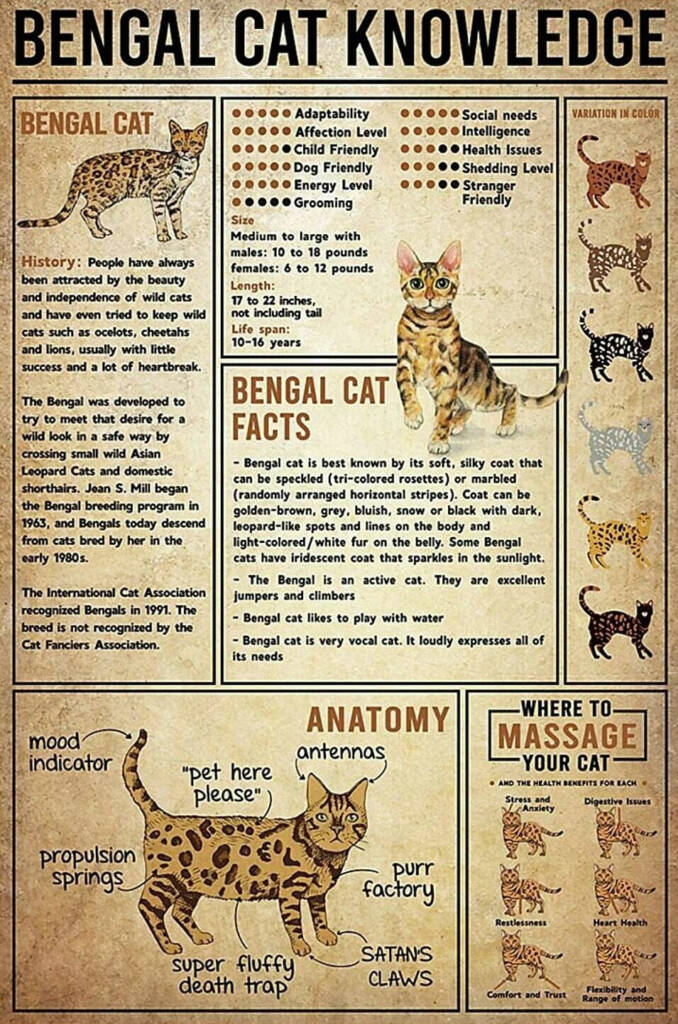The Bengal Breed
Domestic Bengal cats are hybrid cats. They are bred from the Asian Leopard Cat (ALC), a native of South, Southeast, and East Asia. The ALC is one of the most widespread carnivore species in Asia. Their habitat is mostly forest and jungle areas throughout the region, but have been known to enter more agricultural areas in search of food sources. They are typically about the size of most standard domestic breeds, although typically they are longer legged. However, the Asian Leopard Cat breed has many varying sub-species with different physical characteristics. They tend to be yellowish to brown and even some grays with a white underbelly and dark brown to black spots (rosettes) covering the entire body. Strong climbers, the ALC is definitely a tree dwelling breed. And unlike most housecoats, they are more likely to be comfortable and even play in water.
The Bengal breed we have now was first conceived in the 1960’s by a pediatrics professor named Dr Williard Centerwall who was interested in the ALC’s apparent immunity to feline leukemia and if that immunity could be transferred. In 1980, Jean Sudgen Mill, who is widely considered to be the founder of the breed, received her first cats from Dr. Centerwall. Her hope was to reduce the stress of poaching on small wild cats for private collections. Jean acquired her own ALC, named Kabuki, who together with the Centerwall cats, became the start of the Bengal breed as we know it today.
BENGALS AND YOUR FAMILY
Bengals are a hybrid of the ALC and multiple different breeds of domestic cat. The purpose of those crosses is to maintain as much of the ALC appearance while trying to bring the personality characteristics of the other breeds into the wildcat genetics. Most early generation males tend to be infertile, thus requiring more crossbreeding to obtain stable breeding lines. The International Cat Association does not allow a bengal cat which is considered “early generation” (less than 5 generations removed from a full blooded ALC) to be shown in competition.
However, Bengals do make excellent pets if you are prepared and understand what makes them unique. Bengals tend to be more inclined to interact in water than a typical housecat. Many bengal scan be leash trained and play fetch. Some even learn tricks. However, Bengals are generally more high energy than a typical tabby or siamese. They very much tend to maintain the nocturnal nature of their ALC ancestors. It is not uncommon for a Bengal to have the “zoomies” at 3 in the morning.
Although Bengals tend to be a relatively healthy breed that typically lives around 14 to 18 years, there are a couple common issues. The fortunate thing is that most of these diseases can be tracked through genetic testing which any ethical breeder should be doing. Diseases such as Progressive Retinal Atrophy (PRA) and Pyruvate Kinase Deficiency (PK-Def) can both be tracked in genetics and if the breeding cats don’t carry the markers for these diseases, the kittens should not be in any danger of developing them. The third issue is called Hypertrophic Cardiomyopathy (HCM). This is a heart disease that is common among bengals. Unfortunately, this can not be tracked with genetics. But ethical breeders have tests done on their breeding cats annually to help ensure the cats are healthy enough to undergo the stresses of giving birth.
If you are considering a Bengal addition to your family, make sure you have the time. This isn’t a breed you want to leave alone for long periods. At the least, you’ll want to have a second cat to interact so that they can entertain each other. They are very loving and attentive pets though, and you certainly won’t regret it.
BENGALS AND YOUR FAMILY
The first step in adopting one of our bengals is an APPLICATION. It is just a short form we ask all prospective families to fill out that tells us a little bit more about you. There is no charge for this and no commitment. Click the button below for the application link:
After we receive and review your application, if we feel you’d be a good fit for one of our kittens, we will reach out to arrange a phone interview. Then, should you decide to add one of our kittens to your furever family, we would take a deposit for you to get on our wait list unless you already had a specific kitten selected, which would then be reserved for your family. Final payment would be due prior to taking your kitten/cat home with you. Typically, all our kittens/cats go to furever homes already altered and microchipped. They will be up to date on all vaccines, and carry a one year health guarantee against major diseases.



